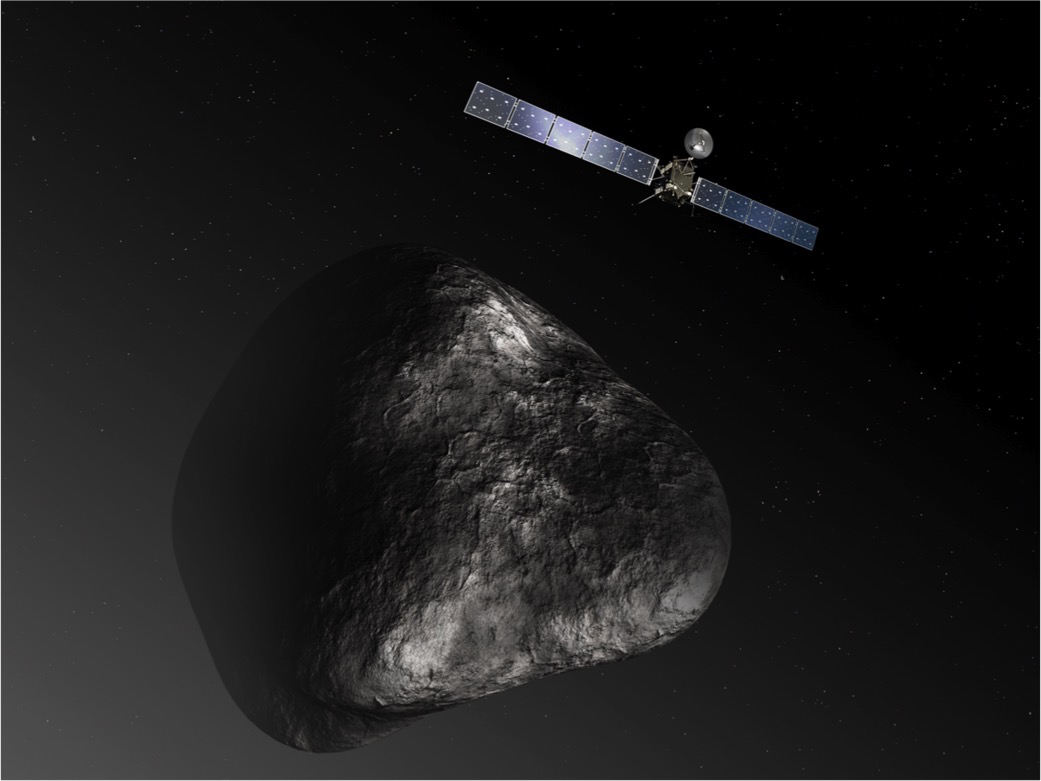First Comet-Orbiting Spacecraft Set to Crash-Land Friday

The first spacecraft to orbit a comet will end its historic mission on Friday (Sept. 30) with a crash landing.
The European Space Agency's (ESA) Rosetta probe has circled Comet 67P/Churyumov-Gerasimenko for the last two years, collecting observations of the primitive chunk of dust and ice. This week, Rosetta will complete a final set of maneuvers to put the craft on a collision course with the comet.
ESA managers said they hope to land Rosetta near active pits on an area at the "head" of the duck-shaped comet. Those pits are dotted with lumpy structures known as "goose bumps," and they produce jets of gas and dust. Comets are among the most ancient bodies in the solar system, and studying their composition and structure could lead to a better understanding of how the sun and planets were formed. [Photos: Europe's Rosetta Comet Mission in Pictures]
Rosetta scientists will speak about the mission in a live stream from the European Space Operations Centre (ESOC) in Darmstadt, Germany, from 8:30 a.m. to 11 a.m. ET (12:30 to 15:00 GMT) on Thursday (Sept. 29). Then, on Friday (Sept. 30), ESA officials expect to receive confirmation of the end of mission around 7:20 a.m. ET (11:20 GMT), give or take 20 minutes. You can watch those events live on Space.com.
Rosetta launched in March 2004, and after a decade-long journey through the solar system, the probe arrived at Comet 67P in August 2014. Then, in November 2014, Rosetta's onboard lander, Philae, was deployed to the comet's surface. But the landing didn't go so smoothly. Philae's anchoring harpoons failed to fire, and the washing-machine-size probe bounced into a shaded area of the comet. (It was only during a flyby of the comet earlier this month that Rosetta could finally capture images of the lander on its side in a crevice.)
With its batteries powered by solar panels, Philae was able to collect only 60 hours of data before going into hibernation, but even this short period of observation gave scientists some insight into the structure and evolution of comets.
Comet 67P orbits the sun once every 6.5 years, making its closest approach to the sun in August 2015. Since then, the comet (and Rosetta) have been traveling farther and farther away from the sun. The mission has to come to an end soon, as Rosetta's solar panels will no longer be able to power the spacecraft. The probe is not designed to survive the landing, or even to withstand gravity; at the moment of impact, Rosetta will be crushed and its signal will go dark, ESA managers said.
Get the Space.com Newsletter
Breaking space news, the latest updates on rocket launches, skywatching events and more!
Follow Megan Gannon @meganigannon, or Space.com @Spacedotcom. We're also on Facebook and Google+. Original article on Space.com.
Join our Space Forums to keep talking space on the latest missions, night sky and more! And if you have a news tip, correction or comment, let us know at: community@space.com.

Megan has been writing for Live Science and Space.com since 2012. Her interests range from archaeology to space exploration, and she has a bachelor's degree in English and art history from New York University. Megan spent two years as a reporter on the national desk at NewsCore. She has watched dinosaur auctions, witnessed rocket launches, licked ancient pottery sherds in Cyprus and flown in zero gravity on a Zero Gravity Corp. to follow students sparking weightless fires for science. Follow her on Twitter for her latest project.
Most Popular

